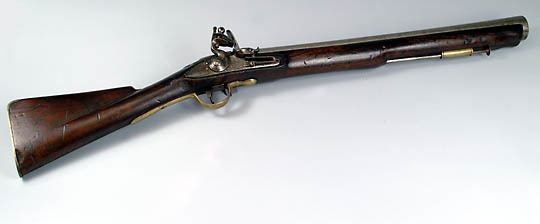 | ||
Jack white blunderbuss unstaged studio
The blunderbuss is a muzzle-loading firearm with a short, large caliber barrel, which is flared at the muzzle and frequently throughout the entire bore, and used with shot and other projectiles of relevant quantity and/or caliber. The blunderbuss could be considered to be an early form of shotgun, which was often adapted to military and defensive use. It was effective at short ranges, but lacked accuracy for targets at long range. A blunderbuss in handgun form was called a dragon, and it is from this that the term dragoon evolved.
Contents
- Jack white blunderbuss unstaged studio
- Advanced warfare in depth blunderbuss shotgun blunderbuss variants gameplay too
- Etymology
- Construction
- Use
- In popular culture
- References

Advanced warfare in depth blunderbuss shotgun blunderbuss variants gameplay too
Etymology

The term "blunderbuss" is of Dutch origin, from the Dutch word donderbus, which is a combination of donder, meaning "thunder", and bus, meaning "Pipe" (Middle Dutch: busse, box, tube, from Late Latin, buxis, box, from Ancient Greek pyxίs (πυξίς), box: esp. from boxwood).

The transition from donder to blunder is thought by some to be deliberate; the term blunder was originally used in a transitive sense, synonymous with to confuse, and this is thought to describe the stunningly loud report of the large bore, short barreled blunderbuss. The term dragon is taken from the fact that early versions were decorated with a carving in the form of a mythical dragon's head around the muzzle; the muzzle blast would then give the impression of a fire-breathing dragon.
Construction

The blunderbuss could be considered an early shotgun, and served in similar roles. While various old accounts often list the blunderbuss as being loaded with various scrap iron, rocks, or wood, this would result in damage to the bore of the gun; it was typically loaded with a number of lead balls smaller than the bore diameter. Barrels were made of steel or brass.

The muzzle (and often the bore) was flared with the intent not only to increase the spread of the shot, but also to funnel powder and shot into the weapon, making it easier to reload on horseback or on a moving carriage; however, modern experiments have shown that the flared muzzle has no noticeable effect on shot spread. The flared muzzle is the defining feature of the blunderbuss, differentiating it from large caliber carbines; the distinction between the blunderbuss and the musketoon is less distinct, as musketoons were also used to fire shot, and some had flared barrels. Blunderbusses were typically short, with barrels under 2 feet (61 cm) in length, at a time when a typical musket barrel was over 3 feet (91 cm) long. One source, describing arms from the early to middle 17th century, lists the barrel length of a wheel lock dragon at around 11 inches (28 cm), compared to a 16-inch (41 cm) length for a blunderbuss.
Use
The blunderbuss, and especially the dragon, was typically issued to troops such as cavalry, who needed a lightweight, easily handled firearm. The dragon became so associated with cavalry and mounted infantry that the term dragoon became synonymous with mounted infantry. In addition to the cavalry, the blunderbuss found use for other duties in which the shotgun-like qualities were desirable, such as for guarding prisoners or defending a mail coach, and its use for urban combat was also recognized. Blunderbusses were also commonly carried by officers on naval warships, privateers and by pirates for use in close-quarters boarding actions. The Portuguese marines used it widely in the 17th century. Many types of ammunition, including gravel and sand, could be shot in a pinch, but most of the time they were shot using traditional lead balls.
The blunderbuss used by the British Royal Mail during the period of 1788–1816 was a flintlock with a 14-inch (36 cm) long flared brass barrel, brass triggerguard, and an iron trigger and lock. A typical British mail coach would have a single postal employee on board, armed with a blunderbuss and a pair of pistols, to guard the mail from highwaymen. One 18th century coaching blunderbuss in another British collection had a brass barrel 17 inches (43 cm) long, flaring to 2 inches (5.1 cm) at the muzzle; it was also provided with a spring-loaded bayonet, which was held along the barrel by a catch and would spring forward into place when released.
While the blunderbuss is often associated with the Plymouth Colony Pilgrims of 1620, evidence suggests that the blunderbuss was relatively scarce in the American colonies. After the Battle of Lexington in 1775, British General Thomas Gage occupied Boston, Massachusetts, and upon negotiating with the town committee, Gage agreed to let the inhabitants of Boston leave town with their families and effects if they surrendered all arms. While most of the residents of Boston stayed, those who left under the agreement surrendered 1,778 long arms, 634 pistols, 273 bayonets, and only 38 blunderbusses. The blunderbuss did still have its civilian applications, however; the Lewis and Clark Expedition carried a number of blunderbusses, some of which were mounted and used as small swivel guns on the pirogues.
By the middle 19th century, the blunderbuss was considered obsolete and was replaced in military use by the carbine. The latter was considered by some to be a poor replacement, and the blunderbuss still found use by civilians as a defensive firearm. The carbine in use by the British during the Crimean War was lampooned in Punch magazine as being able, in the hands of a good marksman, to "hit a hayrick at 80 yards [73 meters]".
